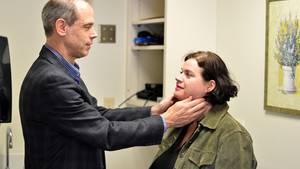It took the lives of Steve Jobs and Aretha Franklin, but it’s not widely discussed or understood.
Neuroendocrine cancer forces us to abandon the narrative that cancer is associated with the organ where it is found and, instead, consider the cell within which it originates.
Neuroendocrine cells are found throughout your body and help control everything from the air and blood through your lungs to the digestive enzymes that break down your food. Neuroendocrine tumours, or NETs, begin in these cells and occur most often in your lungs, appendix, small intestine, rectum and pancreas.
NETs often mimic other illnesses, making it one of the most difficult cancers to detect, often taking five to seven years from a patient’s first symptoms to their official diagnosis. According to the Canadian Neuroendocrine Tumour Society of Canada (CNETS), diagnosis of this type of cancer is complex and often requires sophisticated lab testing and advanced scanning techniques, like the QEII’s new gallium-68 DOTATATE technology.
The QEII Health Sciences Centre recently began scanning its first neuroendocrine cancer patients with gallium-68 DOTATATE — a huge milestone for the Atlantic region — thanks to the QEII Foundation’s $200,200 fundraising campaign.

We recently connected virtually with Jackie Herman, president of CNETS’ board of directors. Located in Toronto, Jackie is a NET patient, activist and national leader within the neuroendocrine cancer community.
In 2015, Jackie entered a clinical trial at an American hospital, where she would first access a gallium-68 scan. For the first time, she received a clear image of the cancer in her body — a peace of mind that couldn’t be offered at home, at that time, here in Canada.
Q: This summer, the QEII began performing its first gallium-68 DOTATATE scans. What makes this milestone so exciting?
A: Until now, neuroendocrine cancer patients living in Eastern Canada in need of this scan were required to travel to Quebec, Ontario or as far away as Alberta to access it. Given that neuroendocrine cancer patients are dealing with health issues, the less travel necessary the better. Having local access in Halifax makes this very important scan more accessible to more Atlantic Canadian patients.
Q: Is this milestone something Atlantic Canadians should be proud of?
A: Most definitely! Thanks to the commitment of the QEII Foundation, including the medical oncology and nuclear medicine champions, Atlantic Canadians now have access to a life-saving scan that unfortunately is still not accessible to all Canadians.

Q: What does a gallium-68 scan offer to those living with known or suspected neuroendocrine cancer?
A: It offers high-quality images that provide information — which exceeds what is available from conventional imaging — that can detect tumors as small as 4 millimeters. The scan has different roles, depending on what the tumour is doing, and can be used for diagnosis, staging and restaging, deciding the best form of treatment and monitoring the effect of treatment. It is also used to identify patients who are viable candidates for peptide receptor radionuclide therapy (PRRT), a molecular therapy that binds directly to the tumour cells’ receptors, avoiding the destruction of healthy cells often found with external beam radiation.
Q: How will it help Atlantic Canadian patients?
A: The gallium-68 DOTATATE scan has the potential to offer a change in treatment plan that can be life-altering for patients. Neuroendocrine tumours are sneaky and hide in places that more traditional scans are not able to see, so this scan is a critical tool in the diagnostic toolbox that every Canadian should have access to.

Q: Is access to this game-changing technology still limited across Canada?
Why is that?
A: Access to gallium-68 DOTATATE is available in many centres in Canada via clinical trials and the pharmaceutical version (NETSPOT) is available in a handful of medical institutions and private clinics, but access is not equitable. I believe this may be driven by cost, including the investment in the necessary technology. Provinces and medical institutions need to be willing to make the investment in this diagnostic tool that can and does change patient lives. The bottom line is it is not readily available as a standard of care across Canada and this needs to change.
Q: What’s your biggest hope for the future when it comes to gallium-68 DOTATATE scans and access from coast to coast?
A: My hope is for every neuroendocrine cancer patient to have access to a gallium-68 scan as a standard tool to make an accurate diagnosis. In the ultimate perfect scenario, we will have no cost or location barriers to gallium-68 in Canada.








